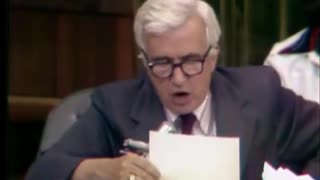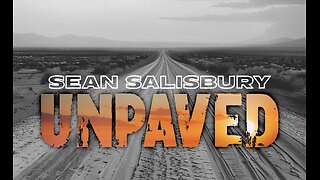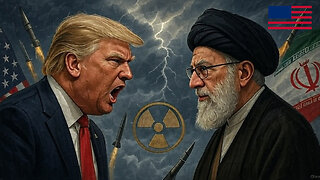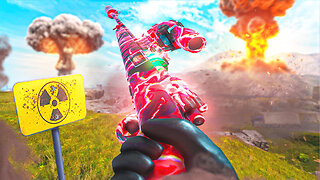Premium Only Content

CIA Archives: Burma (1957)
The dark side of history: https://thememoryhole.substack.com/
Myanmar (Burmese: မြန်မာ; MLCTS: mranma, pronounced [mjàɴ.mà]), officially the Republic of the Union of Myanmar,[d] also known as Burma (the official name until 1989), is a country in Southeast Asia. It is the largest country by area in Mainland Southeast Asia and has a population of about 55 million.[13] It is bordered by Bangladesh and India to its northwest, China to its northeast, Laos and Thailand to its east and southeast, and the Andaman Sea and the Bay of Bengal to its south and southwest. The country's capital city is Naypyidaw, and its largest city is Yangon (formerly Rangoon).[3]
Early civilisations in the area included the Tibeto-Burman-speaking Pyu city-states in Upper Myanmar and the Mon kingdoms in Lower Myanmar.[14] In the 9th century, the Bamar people entered the upper Irrawaddy valley, and following the establishment of the Pagan Kingdom in the 1050s, the Burmese language, culture, and Theravada Buddhism slowly became dominant in the country. The Pagan Kingdom fell to Mongol invasions, and several warring states emerged. In the 16th century, reunified by the Taungoo dynasty, the country became the largest empire in the history of Southeast Asia for a short period.[15] The early 19th-century Konbaung dynasty ruled over an area that included modern Myanmar and briefly controlled Manipur and Assam as well. The British East India Company seized control of the administration of Myanmar after three Anglo-Burmese Wars in the 19th century, and the country became a British colony. After a brief Japanese occupation, Myanmar was reconquered by the Allies. On 4 January 1948, Myanmar declared independence under the terms of the Burma Independence Act 1947.
Myanmar's post-independence history has continued to be checkered by unrest and conflict. The coup d'état in 1962 resulted in a military dictatorship under the Burma Socialist Programme Party. On 8 August 1988, the 8888 Uprising then resulted in a nominal transition to a multi-party system two years later, but the country's post-uprising military council refused to cede power, and has continued to rule the country through to the present. The country remains riven by ethnic strife among its myriad ethnic groups and has one of the world's longest-running ongoing civil wars. The United Nations and several other organisations have reported consistent and systemic human rights violations in the country.[16] In 2011, the military junta was officially dissolved following a 2010 general election, and a nominally civilian government was installed. Aung San Suu Kyi and political prisoners were released and the 2015 Myanmar general election was held, leading to improved foreign relations and eased economic sanctions,[17] although the country's treatment of its ethnic minorities, particularly in connection with the Rohingya conflict, continued to be a source of international tension and consternation.[18] Following the 2020 Myanmar general election, in which Aung San Suu Kyi's party won a clear majority in both houses, the Burmese military (Tatmadaw) again seized power in a coup d'état.[19] The coup, which was widely condemned by the international community, led to continuous ongoing widespread protests in Myanmar and has been marked by violent political repression by the military, as well as a larger outbreak of the civil war.[20] The military also arrested Aung San Suu Kyi in order to remove her from public life, and charged her with crimes ranging from corruption to the violation of COVID-19 protocols; all of the charges against her are "politically motivated" according to independent observers.[21]
Myanmar is a member of the East Asia Summit, Non-Aligned Movement, ASEAN, and BIMSTEC, but it is not a member of the Commonwealth of Nations despite once being part of the British Empire. Myanmar is a Dialogue Partner of the Shanghai Cooperation Organization. The country is very rich in natural resources, such as jade, gems, oil, natural gas, teak and other minerals, as well as also endowed with renewable energy, having the highest solar power potential compared to other countries of the Great Mekong Subregion.[22] However, Myanmar has long suffered from instability, factional violence, corruption, poor infrastructure, as well as a long history of colonial exploitation with little regard to human development.[23] In 2013, its GDP (nominal) stood at US$56.7 billion and its GDP (PPP) at US$221.5 billion.[24] The income gap in Myanmar is among the widest in the world, as a large proportion of the economy is controlled by cronies of the military junta.[25] Myanmar is one of the least developed countries; as of 2020, according to the Human Development Index, it ranks 147 out of 189 countries in terms of human development, the lowest in Southeast Asia.[12] Since 2021, more than 600,000 people were displaced across Myanmar due to the surge in violence post-coup, with more than 3 million people in dire need of humanitarian assistance.[26]
Etymology
Main article: Names of Myanmar
The name of the country has been a matter of dispute and disagreement, particularly in the early 21st century, focusing mainly on the political legitimacy of those using Myanmar versus Burma.[27][28] Both names derive from the earlier Burmese Mranma or Mramma, an ethnonym for the majority Burman ethnic group, of uncertain etymology.[29] The terms are also popularly thought to derive from Sanskrit Brahma Desha, 'land of Brahma'.[30]
In 1989, the military government officially changed the English translations of many names dating back to Burma's colonial period or earlier, including that of the country itself: Burma became Myanmar. The renaming remains a contested issue.[31] Many political and ethnic opposition groups and countries continue to use Burma because they do not recognise the legitimacy or authority of the military government.[32]
The country's official full name is "Republic of the Union of Myanmar" (Burmese: ပြည်ထောင်စုသမ္မတ မြန်မာနိုင်ငံတော်, Pyihtaungsu Thamada Myanma Naingngantaw, pronounced [pjìdàʊɴzṵ θàɴməda̰ mjəmà nàɪɴŋàɴdɔ̀]). Countries that do not officially recognise that name use the long form "Union of Burma" instead.[3][33] In English, the country is popularly known as either Burma or Myanmar. In Burmese, the pronunciation depends on the register used and is either Bama (pronounced [bəmà]) or Myamah (pronounced [mjəmà]).[31]
Official United States foreign policy retains Burma as the country's name although the State Department's website lists the country as Burma (Myanmar).[34] The United Nations uses Myanmar, as does the ASEAN and as do Australia,[35] Russia, Germany,[36] China, India, Bangladesh, Norway,[37] Japan,[38] Switzerland,[39] and Canada.[40] Most English-speaking international news media refer to the country by the name Myanmar, including the BBC,[41] CNN,[42] Al Jazeera,[43] Reuters,[44] and the Australian Broadcasting Corporation (ABC)/Radio Australia.[45] Myanmar is known by a name deriving from Burma in Spanish, Italian, Romanian, and Greek.[46] French-language media consistently use Birmanie.[47][48]
There are at least nine different pronunciations of the English name Myanmar, and no single one is standard. Pronunciations with two syllables are found most often in major British and American dictionaries.[pronunciations 1] Dictionaries—such as Collins—and other sources also report pronunciations with three syllables.[pronunciations 2][49]
As John Wells explains, the English spellings of both Myanmar and Burma assume a non-rhotic variety of English, in which the letter r before a consonant or finally serves merely to indicate a long vowel: [ˈmjænmɑː, ˈbɜːmə]. So the pronunciation of the last syllable of Myanmar as [mɑːr] or of Burma as [ˈbɜːrmə] by some speakers in the UK and most speakers in North America is in fact a spelling pronunciation based on a misunderstanding of non-rhotic spelling conventions.
History
This section needs additional citations for verification. Please help improve this article by adding citations to reliable sources in this section. Unsourced material may be challenged and removed.
Find sources: "Myanmar" – news · newspapers · books · scholar · JSTOR (August 2022) (Learn how and when to remove this template message)
Main article: History of Myanmar
Prehistory
Main articles: Prehistory of Myanmar and Migration period of ancient Burma
Pyu city-states, c. 8th century; Pagan is shown for comparison only and is not contemporary.
Archaeological evidence shows that Homo erectus lived in the region now known as Myanmar as early as 750,000 years ago, with no more erectus finds after 75,000 years ago.[50] The first evidence of Homo sapiens is dated to about 25,000 BP with discoveries of stone tools in central Myanmar.[51] Evidence of Neolithic age domestication of plants and animals and the use of polished stone tools dating to sometime between 10,000 and 6,000 BCE has been discovered in the form of cave paintings in Padah-Lin Caves.[52]
The Bronze Age arrived c. 1500 BCE when people in the region were turning copper into bronze, growing rice and domesticating poultry and pigs; they were among the first people in the world to do so.[53] Human remains and artefacts from this era were discovered in Monywa District in the Sagaing Region.[54] The Iron Age began around 500 BCE with the emergence of iron-working settlements in an area south of present-day Mandalay.[55] Evidence also shows the presence of rice-growing settlements of large villages and small towns that traded with their surroundings as far as China between 500 BCE and 200 CE.[56] Iron Age Burmese cultures also had influences from outside sources such as India and Thailand, as seen in their funerary practices concerning child burials. This indicates some form of communication between groups in Myanmar and other places, possibly through trade.[57]
Early city-states
Main articles: Pyu city-states and Mon kingdoms
Around the second century BCE the first-known city-states emerged in central Myanmar. The city-states were founded as part of the southward migration by the Tibeto-Burman-speaking Pyu people, the earliest inhabitants of Myanmar of whom records are extant, from present-day Yunnan.[58] The Pyu culture was heavily influenced by trade with India, importing Buddhism as well as other cultural, architectural and political concepts, which would have an enduring influence on later Burmese culture and political organisation.[59]
By the 9th century, several city-states had sprouted across the land: the Pyu in the central dry zone, Mon along the southern coastline and Arakanese along the western littoral. The balance was upset when the Pyu came under repeated attacks from Nanzhao between the 750s and the 830s. In the mid-to-late 9th century the Bamar people founded a small settlement at Bagan. It was one of several competing city-states until the late 10th century, when it grew in authority and grandeur.[60]
Pagan Kingdom
Main articles: Pagan Kingdom, Toungoo dynasty, and Konbaung dynasty
See also: Kingdom of Ava, Hanthawaddy Kingdom, Kingdom of Mrauk U, and Shan States
Pagodas and kyaungs in present-day Bagan, the capital of the Pagan Kingdom
Pagan gradually grew to absorb its surrounding states until the 1050s–1060s when Anawrahta founded the Pagan Kingdom, the first ever unification of the Irrawaddy valley and its periphery. In the 12th and 13th centuries, the Pagan Empire and the Khmer Empire were two main powers in mainland Southeast Asia.[61] The Burmese language and culture gradually became dominant in the upper Irrawaddy valley, eclipsing the Pyu, Mon and Pali norms[clarification needed] by the late 12th century.[62] Theravada Buddhism slowly began to spread to the village level, although Tantric, Mahayana, Hinduism, and folk religion remained heavily entrenched. Pagan's rulers and wealthy built over 10,000 Buddhist temples in the Pagan capital zone alone. Repeated Mongol invasions in the late 13th century toppled the four-century-old kingdom in 1287.[62]
Temples at Mrauk U.
Pagan's collapse was followed by 250 years of political fragmentation that lasted well into the 16th century. Like the Burmans four centuries earlier, Shan migrants who arrived with the Mongol invasions stayed behind. Several competing Shan States came to dominate the entire northwestern to eastern arc surrounding the Irrawaddy valley. The valley too was beset with petty states until the late 14th century when two sizeable powers, Ava Kingdom and Hanthawaddy Kingdom, emerged. In the west, a politically fragmented Arakan was under competing influences of its stronger neighbours until the Kingdom of Mrauk U unified the Arakan coastline for the first time in 1437. The kingdom was a protectorate of the Bengal Sultanate at different time periods.[63]
In the 14th and 15th centuries, Ava fought wars of unification but could never quite reassemble the lost empire. Having held off Ava, the Mon-speaking Hanthawaddy entered its golden age, and Arakan went on to become a power in its own right for the next 350 years. In contrast, constant warfare left Ava greatly weakened, and it slowly disintegrated from 1481 onward. In 1527, the Confederation of Shan States conquered Ava and ruled Upper Myanmar until 1555.
Like the Pagan Empire, Ava, Hanthawaddy and the Shan states were all multi-ethnic polities. Despite the wars, cultural synchronisation continued. This period is considered a golden age for Burmese culture. Burmese literature "grew more confident, popular, and stylistically diverse", and the second generation of Burmese law codes as well as the earliest pan-Burma chronicles emerged.[64] Hanthawaddy monarchs introduced religious reforms that later spread to the rest of the country.[65]
Taungoo and Konbaung
Toungoo Empire under Bayinnaung in 1580
Myanmar (缅甸国) delegates in Peking in 1761, at the time of Emperor Qianlong. 万国来朝图
Political unification returned in the mid-16th century, through the efforts of Taungoo, a former vassal state of Ava. Taungoo's young, ambitious King Tabinshwehti defeated the more powerful Hanthawaddy in the Toungoo–Hanthawaddy War. His successor Bayinnaung went on to conquer a vast swath of mainland Southeast Asia including the Shan states, Lan Na, Manipur, Mong Mao, the Ayutthaya Kingdom, Lan Xang and southern Arakan. However, the largest empire in the history of Southeast Asia unravelled soon after Bayinnaung's death in 1581, completely collapsing by 1599. Ayutthaya seized Tenasserim and Lan Na, and Portuguese mercenaries established Portuguese rule at Thanlyin (Syriam).
The dynasty regrouped and defeated the Portuguese in 1613 and Siam in 1614. It restored a smaller, more manageable kingdom, encompassing Lower Myanmar, Upper Myanmar, Shan states, Lan Na and upper Tenasserim. The restored Toungoo kings created a legal and political framework whose basic features continued well into the 19th century. The crown completely replaced the hereditary chieftainships with appointed governorships in the entire Irrawaddy valley and greatly reduced the hereditary rights of Shan chiefs. Its trade and secular administrative reforms built a prosperous economy for more than 80 years. From the 1720s onward, the kingdom was beset with repeated Meithei raids into Upper Myanmar and a nagging rebellion in Lan Na. In 1740, the Mon of Lower Myanmar founded the Restored Hanthawaddy Kingdom. Hanthawaddy forces sacked Ava in 1752, ending the 266-year-old Toungoo Dynasty.
A British 1825 lithograph of Shwedagon Pagoda shows British occupation during the First Anglo-Burmese War.
After the fall of Ava, the Konbaung–Hanthawaddy War involved one resistance group under Alaungpaya defeating the Restored Hanthawaddy, and by 1759 he had reunited all of Myanmar and Manipur and driven out the French and the British, who had provided arms to Hanthawaddy. By 1770, Alaungpaya's heirs had subdued much of Laos and fought and won the Burmese–Siamese War against Ayutthaya and the Sino-Burmese War against Qing China.[66]
With Burma preoccupied by the Chinese threat, Ayutthaya recovered its territories by 1770 and went on to capture Lan Na by 1776. Burma and Siam went to war until 1855, but all resulted in a stalemate, exchanging Tenasserim (to Burma) and Lan Na (to Ayutthaya). Faced with a powerful China and a resurgent Ayutthaya in the east, King Bodawpaya turned west, acquiring Arakan (1785), Manipur (1814) and Assam (1817). It was the second-largest empire in Burmese history but also one with a long ill-defined border with British India.[67]
In 1826, Burma lost Arakan, Manipur, Assam and Tenasserim to the British in the First Anglo-Burmese War. In 1852, the British easily seized Lower Burma in the Second Anglo-Burmese War. King Mindon Min tried to modernise the kingdom and in 1875 narrowly avoided annexation by ceding the Karenni States. The British, alarmed by the consolidation of French Indochina, annexed the remainder of the country in the Third Anglo-Burmese War in 1885.
Konbaung kings extended Restored Toungoo's administrative reforms and achieved unprecedented levels of internal control and external expansion. For the first time in history, the Burmese language and culture came to predominate the entire Irrawaddy valley. The evolution and growth of Burmese literature and theatre continued, aided by an extremely high adult male literacy rate for the era (half of all males and 5% of females).[68] Nonetheless, the extent and pace of reforms were uneven and ultimately proved insufficient to stem the advance of British colonialism.
British Burma (1885–1948)
Main articles: British rule in Burma and Burma campaign
The landing of British forces in Mandalay after the last of the Anglo-Burmese Wars, which resulted in the abdication of the last Burmese monarch, King Thibaw Min
British troops firing a mortar on the Mawchi road, July 1944
In the 19th century, Burmese rulers sought to maintain their traditional influence in the western areas of Assam, Manipur and Arakan. Pressing them, however, was the British East India Company, which was expanding its interests eastwards over the same territory. Over the next sixty years, diplomacy, raids, treaties and compromises, known collectively as the Anglo-Burmese Wars, continued until Britain proclaimed control over most of Burma.[69] With the fall of Mandalay, all of Burma came under British rule, being annexed on 1 January 1886.
Throughout the colonial era, many Indians arrived as soldiers, civil servants, construction workers and traders and, along with the Anglo-Burmese community, dominated commercial and civil life in Burma. Rangoon became the capital of British Burma and an important port between Calcutta and Singapore. Burmese resentment was strong, and was vented in violent riots that periodically paralysed Rangoon until the 1930s.[70] Some of the discontent was caused by a disrespect for Burmese culture and traditions. Buddhist monks became the vanguards of the independence movement. U Wisara, an activist monk, died in prison after a 166-day hunger strike.[71]
On 1 April 1937, Burma became a separately administered colony of Britain, and Ba Maw became the first Prime Minister and Premier of Burma. Ba Maw was an outspoken advocate for Burmese self-rule, and he opposed the participation of Britain, and by extension Burma, in World War II. He resigned from the Legislative Assembly and was arrested for sedition. In 1940, before Japan formally entered the war, Aung San formed the Burma Independence Army in Japan.
As a major battleground, Burma was devastated during World War II by the Japanese invasion. Within months after they entered the war, Japanese troops had advanced on Rangoon, and the British administration had collapsed. A Burmese Executive Administration headed by Ba Maw was established by the Japanese in August 1942. Wingate's British Chindits were formed into long-range penetration groups trained to operate deep behind Japanese lines.[72] A similar American unit, Merrill's Marauders, followed the Chindits into the Burmese jungle in 1943.[73]
Beginning in late 1944, allied troops launched a series of offensives that led to the end of Japanese rule in July 1945. The battles were intense with much of Burma laid waste by the fighting. Overall, the Japanese lost some 150,000 men in Burma with 1,700 prisoners taken.[74] Although many Burmese fought initially for the Japanese as part of the Burma Independence Army, many Burmese, mostly from the ethnic minorities, served in the British Burma Army.[75] The Burma National Army and the Arakan National Army fought with the Japanese from 1942 to 1944 but switched allegiance to the Allied side in 1945. Overall, 170,000 to 250,000 Burmese civilians died during World War II.[76]
Following World War II, Aung San negotiated the Panglong Agreement with ethnic leaders that guaranteed the independence of Myanmar as a unified state. Aung Zan Wai, Pe Khin, Bo Hmu Aung, Sir Maung Gyi, Sein Mya Maung, Myoma U Than Kywe were among the negotiators of the historic Panglong Conference negotiated with Bamar leader General Aung San and other ethnic leaders in 1947. In 1947, Aung San became Deputy Chairman of the Executive Council of Myanmar, a transitional government. But in July 1947, political rivals[77] assassinated Aung San and several cabinet members.[78]
Independence (1948–1962)
Main article: Post-independence Burma (1948–1962)
British governor Hubert Elvin Rance and Sao Shwe Thaik at the flag-raising ceremony on 4 January 1948 (Independence Day of Burma)
On 4 January 1948, the nation became an independent republic, under the terms of the Burma Independence Act 1947. The new country was named the Union of Burma, with Sao Shwe Thaik as its first president and U Nu as its first prime minister. Unlike most other former British colonies and overseas territories, Burma did not become a member of the Commonwealth. A bicameral parliament was formed, consisting of a Chamber of Deputies and a Chamber of Nationalities,[79] and multi-party elections were held in 1951–1952, 1956 and 1960.
The geographical area Burma encompasses today can be traced to the Panglong Agreement, which combined Burma Proper, which consisted of Lower Burma and Upper Burma, and the Frontier Areas, which had been administered separately by the British.[80]
In 1961, U Thant, the Union of Burma's Permanent Representative to the United Nations and former secretary to the prime minister, was elected Secretary-General of the United Nations, a position he held for ten years.[81]
When the non-Burman ethnic groups pushed for autonomy or federalism, alongside having a weak civilian government at the centre, the military leadership staged a coup d'état in 1962. Though incorporated in the 1947 Constitution, successive military governments construed the use of the term 'federalism' as being anti-national, anti-unity and pro-disintegration.[82]
Military rule (1962–2011)
On 2 March 1962, the military led by General Ne Win took control of Burma through a coup d'état, and the government had been under direct or indirect control by the military since then. Between 1962 and 1974, Myanmar was ruled by a revolutionary council headed by the general. Almost all aspects of society (business, media, production) were nationalised or brought under government control under the Burmese Way to Socialism,[83] which combined Soviet-style nationalisation and central planning.
A new constitution of the Socialist Republic of the Union of Burma was adopted in 1974. Until 1988, the country was ruled as a one-party system, with the general and other military officers resigning and ruling through the Burma Socialist Programme Party (BSPP).[84] During this period, Myanmar became one of the world's most impoverished countries.[85] There were sporadic protests against military rule during the Ne Win years, and these were almost always violently suppressed. On 7 July 1962, the government broke up demonstrations at Rangoon University, killing 15 students.[83] In 1974, the military violently suppressed anti-government protests at the funeral of U Thant. Student protests in 1975, 1976, and 1977 were quickly suppressed by overwhelming force.[84]
In 1988, unrest over economic mismanagement and political oppression by the government led to widespread pro-democracy demonstrations throughout the country known as the 8888 Uprising. Security forces killed thousands of demonstrators, and General Saw Maung staged a coup d'état and formed the State Law and Order Restoration Council (SLORC). In 1989, SLORC declared martial law after widespread protests. The military government finalised plans for People's Assembly elections on 31 May 1989.[86] SLORC changed the country's official English name from the "Socialist Republic of the Union of Burma" to the "Union of Myanmar" on 18 June 1989 by enacting the adaptation of the expression law.
In May 1990, the government held free multiparty elections for the first time in almost 30 years, and the National League for Democracy (NLD), the party of Aung San Suu Kyi, won[87] earning 392 out of a total 492 seats (i.e., 80% of the seats). However, the military junta refused to cede power[88] and continued to rule the nation, first as SLORC and, from 1997, as the State Peace and Development Council (SPDC) until its dissolution in March 2011. General Than Shwe took over the Chairmanship – effectively the position of Myanmar's top ruler – from General Saw Maung in 1992 and held it until 2011.[89]
On 23 June 1997, Myanmar was admitted into the Association of Southeast Asian Nations. On 27 March 2006, the military junta, which had moved the national capital from Yangon to a site near Pyinmana in November 2005, officially named the new capital Naypyidaw, meaning "city of the kings".[90]
Protesters in Yangon during the 2007 Saffron Revolution with a banner that reads non-violence: national movement in Burmese. In the background is Shwedagon Pagoda.
Cyclone Nargis in southern Myanmar, May 2008.
In August 2007, an increase in the price of fuel led to the Saffron Revolution led by Buddhist monks that were dealt with harshly by the government.[91] The government cracked down on them on 26 September 2007, with reports of barricades at the Shwedagon Pagoda and monks killed. There were also rumours of disagreement within the Burmese armed forces, but none was confirmed. The military crackdown against unarmed protesters was widely condemned as part of the international reactions to the Saffron Revolution and led to an increase in economic sanctions against the Burmese Government.
In May 2008, Cyclone Nargis caused extensive damage in the densely populated rice-farming delta of the Irrawaddy Division.[92] It was the worst natural disaster in Burmese history with reports of an estimated 200,000 people dead or missing, damages totalled to 10 billion US dollars, and as many as 1 million were left homeless.[93] In the critical days following this disaster, Myanmar's isolationist government was accused of hindering United Nations recovery efforts.[94] Humanitarian aid was requested, but concerns about foreign military or intelligence presence in the country delayed the entry of United States military planes delivering medicine, food, and other supplies.[95]
In early August 2009, a conflict broke out in Shan State in northern Myanmar. For several weeks, junta troops fought against ethnic minorities including the Han Chinese,[96] Wa, and Kachin.[97][98] During 8–12 August, the first days of the conflict, as many as 10,000 Burmese civilians fled to Yunnan in neighbouring China.[97][98][99]
Civil wars
Main article: Internal conflict in Myanmar
Civil wars have been a constant feature of Myanmar's socio-political landscape since the attainment of independence in 1948. These wars are predominantly struggles for ethnic and sub-national autonomy, with the areas surrounding the ethnically Bamar central districts of the country serving as the primary geographical setting of conflict. Foreign journalists and visitors require a special travel permit to visit the areas in which Myanmar's civil wars continue.[100]
In October 2012, the ongoing conflicts in Myanmar included the Kachin conflict,[101] between the Pro-Christian Kachin Independence Army and the government;[102] a civil war between the Rohingya Muslims and the government and non-government groups in Rakhine State;[103] and a conflict between the Shan,[104] Lahu, and Karen[105][106] minority groups, and the government in the eastern half of the country. In addition, al-Qaeda signalled an intention to become involved in Myanmar.[107]
Armed conflict between ethnic Chinese rebels and the Myanmar Armed Forces resulted in the Kokang offensive in February 2015. The conflict had forced 40,000 to 50,000 civilians to flee their homes and seek shelter on the Chinese side of the border.[108] During the incident, the government of China was accused of giving military assistance to the ethnic Chinese rebels.[109] Clashes between Burmese troops and local insurgent groups have continued, fuelling tensions between China and Myanmar.[110]
Period of liberalisation, 2011–2021
See also: 2011–2015 Myanmar political reforms
The military-backed Government had promulgated a "Roadmap to Discipline-flourishing Democracy" in 1993, but the process appeared to stall several times, until 2008 when the Government published a new draft national constitution, and organised a (flawed) national referendum which adopted it. The new constitution provided for election of a national assembly with powers to appoint a president, while practically ensuring army control at all levels.[111]
U.S. President Barack Obama and Secretary of State Hillary Clinton with Aung San Suu Kyi and her staff at her home in Yangon, 2012
A general election in 2010 - the first for twenty years - was boycotted by the NLD. The military-backed Union Solidarity and Development Party declared victory, stating that it had been favoured by 80 per cent of the votes; fraud, however, was alleged.[112][113] A nominally civilian government was then formed, with retired general Thein Sein as president.[114]
A series of liberalising political and economic actions – or reforms – then took place. By the end of 2011 these included the release of pro-democracy leader Aung San Suu Kyi from house arrest, the establishment of the National Human Rights Commission, the granting of general amnesties for more than 200 political prisoners, new labour laws that permitted labour unions and strikes, a relaxation of press censorship, and the regulation of currency practices.[115] In response, United States Secretary of State Hillary Clinton visited Myanmar in December 2011 – the first visit by a US Secretary of State in more than fifty years[116] – meeting both President Thein Sein and opposition leader Aung San Suu Kyi.[117]
Aung San Suu Kyi's NLD party participated in the 2012 by-elections, facilitated by the government's abolition of the laws that previously barred it.[118] In the April 2012 by-elections, the NLD won 43 of the 45 available seats. The 2012 by-elections were also the first time that international representatives were allowed to monitor the voting process in Myanmar.[119]
Myanmar's improved international reputation was indicated by ASEAN's approval of Myanmar's bid for the position of ASEAN chair in 2014.[120]
Map of Myanmar and its divisions, including Shan State, Kachin State, Rakhine State and Karen State.
2015 general elections
General elections were held on 8 November 2015. These were the first openly contested elections held in Myanmar since the 1990 general election (which was annulled[121]). The results gave the NLD an absolute majority of seats in both chambers of the national parliament, enough to ensure that its candidate would become president, while NLD leader Aung San Suu Kyi is constitutionally barred from the presidency.[121][122]
The new parliament convened on 1 February 2016,[123] and on 15 March 2016, Htin Kyaw was elected as the first non-military president since the military coup of 1962.[124] On 6 April 2016, Aung San Suu Kyi assumed the newly created role of state counsellor, a role akin to a prime minister.[125]
Coup d'état and civil war
Main article: 2021 Myanmar coup d'état
See also: 2021–2022 Myanmar protests and Myanmar civil war (2021–present)
In Myanmar's 2020 parliamentary election, the ostensibly ruling National League for Democracy (NLD), the party of State Counsellor Aung San Suu Kyi, competed with various other smaller parties – particularly the military-affiliated Union Solidarity and Development Party (USDP).[126] Suu Kyi's NLD won the 2020 Myanmar general election on 8 November in a landslide,[126][127][128] The USDP, regarded as a proxy for the military, suffered a "humiliating" defeat[129][130] – even worse than in 2015[130] – capturing only 33 of the 476 elected seats.[128][129]
As the election results began emerging, the USDP rejected them, urging a new election with the military as observers.[126][130] More than 90 other smaller parties contested the vote, including more than 15 who complained of irregularities. However, election observers declared there were no major irregularities.[129][128][131] However, despite the election commission validating the NLD's overwhelming victory,[131] the USDP and Myanmar's military persistently alleged fraud.[132][133][129][134][135][136][137] In January, 2021, just before the new parliament was to be sworn in, The NLD announced that Suu Kyi would retain her State Counsellor role in the upcoming government. [138]
In the early morning of 1 February 2021, the day parliament was set to convene, the Tatmadaw, Myanmar's military, detained Suu Kyi and other members of the ruling party.[129] [139][140] The military handed power to military chief Min Aung Hlaing and declared a state of emergency for one year[141][139] and began closing the borders, restricting travel and electronic communications nationwide.[140] The military announced it would replace the existing election commission with a new one, and a military media outlet indicated new elections would be held in about one year – though the military avoided making an official commitment to that.[140] The military expelled NLD party Members of Parliament from the capital city, Naypyidaw.[140] By 15 March 2021 the military leadership continued to extend martial law into more parts of Yangon, while security forces killed 38 people in a single day of violence.[142]
Protesters against the military coup in Myanmar
By the second day of the coup, thousands of protesters were marching in the streets of Yangon, and other protests erupted nationwide, largely halting commerce and transportation. Despite the military's arrests and killings of protesters, the first weeks of the coup found growing public participation, including groups of civil servants, teachers, students, workers, monks and religious leaders – even normally disaffected ethnic minorities.[143][144][140]
The coup was immediately condemned by the United Nations Secretary General, and leaders of democratic nations. The U.S. threatened sanctions on the military and its leaders, including a "freeze" of US$1 billion of their assets in the U.S.[143][140] India, Pakistan, Bangladesh, Russia, Vietnam, Thailand, the Philippines and China refrained from criticizing the military coup.[145][146][147][148] A United Nations Security Council resolution called for the release of Aung San Suu Kyi and the other detained leaders[143][140] – a position shared by the United Nations High Commissioner for Human Rights.[140]
International development and aid partners – business, non-governmental, and governmental – hinted at suspension of partnerships with Myanmar. Banks were closed and social media communications platforms, including Facebook and Twitter, removed Tatmadaw postings. Protesters appeared at Myanmar embassies in foreign countries.[143][140] The National Unity Government then declared the formation of an armed wing on 5 May 2021, a date that is often cited as the start of a full-scale civil war. This armed wing was named the People's Defence Force (PDF) to protect its supporters from military junta attacks and as a first step towards a Federal Union Army. The civil war is ongoing as of 2023.[149][150]
Geography
Main article: Geography of Myanmar
Myanmar has a total area of 678,500 square kilometres (262,000 sq mi). It lies between latitudes 9° and 29°N, and longitudes 92° and 102°E. Myanmar is bordered in the northwest by the Chittagong Division of Bangladesh and the Mizoram, Manipur, Nagaland and Arunachal Pradesh states of India. Its north and northeast border is with the Tibet Autonomous Region and Yunnan for a Sino-Myanmar border total of 2,185 km (1,358 mi). It is bounded by Laos and Thailand to the southeast. Myanmar has 1,930 km (1,200 mi) of contiguous coastline along the Bay of Bengal and Andaman Sea to the southwest and the south, which forms one quarter of its total perimeter.[3]
In the north, the Hengduan Mountains form the border with China. Hkakabo Razi, located in Kachin State, at an elevation of 5,881 metres (19,295 ft), is the highest point in Myanmar.[151] Many mountain ranges, such as the Rakhine Yoma, the Bago Yoma, the Shan Hills and the Tenasserim Hills exist within Myanmar, all of which run north-to-south from the Himalayas.[152] The mountain chains divide Myanmar's three river systems, which are the Irrawaddy, Salween (Thanlwin), and the Sittaung rivers.[153] The Irrawaddy River, Myanmar's longest river at nearly 2,170 kilometres (1,348 mi), flows into the Gulf of Martaban. Fertile plains exist in the valleys between the mountain chains.[152] The majority of Myanmar's population lives in the Irrawaddy valley, which is situated between the Rakhine Yoma and the Shan Plateau.
Administrative divisions
Main article: Administrative divisions of Myanmar
A clickable map of Burma/Myanmar exhibiting its first-level administrative divisions.
Myanmar is divided into seven states (ပြည်နယ်) and seven regions (တိုင်းဒေသကြီး), formerly called divisions.[154] Regions are predominantly Bamar (that is, mainly inhabited by Myanmar's dominant ethnic group). States, in essence, are regions that are home to particular ethnic minorities. The administrative divisions are further subdivided into districts, which are further subdivided into townships, wards, and villages.
Below are the number of districts, townships, cities/towns, wards, village groups and villages in each division and state of Myanmar as of 31 December 2001:[155]
No. State/Region Districts Town
ships Cities/
Towns Wards Village
groups Villages
1 Kachin State 4 18 20 116 606 2630
2 Kayah State 2 7 7 29 79 624
3 Kayin State 3 7 10 46 376 2092
4 Chin State 2 9 9 29 475 1355
5 Sagaing Region 8 37 37 171 1769 6095
6 Tanintharyi Region 3 10 10 63 265 1255
7 Bago Region 4 28 33 246 1424 6498
8 Magway Region 5 25 26 160 1543 4774
9 Mandalay Region 7 31 29 259 1611 5472
10 Mon State 2 10 11 69 381 1199
11 Rakhine State 4 17 17 120 1041 3871
12 Yangon Region 4 45 20 685 634 2119
13 Shan State 11 54 54 336 1626 15513
14 Ayeyarwady Region 6 26 29 219 1912 11651
Total 63 324 312 2548 13742 65148
Climate
Main article: Climate of Myanmar
Myanmar map of Köppen climate classification.
Much of the country lies between the Tropic of Cancer and the Equator. It lies in the monsoon region of Asia, with its coastal regions receiving over 5,000 mm (196.9 in) of rain annually. Annual rainfall in the delta region is approximately 2,500 mm (98.4 in), while average annual rainfall in the dry zone in central Myanmar is less than 1,000 mm (39.4 in). The northern regions of Myanmar are the coolest, with average temperatures of 21 °C (70 °F). Coastal and delta regions have an average maximum temperature of 32 °C (89.6 °F).[153] Previously and currently analysed data, as well as future projections on changes caused by climate change predict serious consequences to development for all economic, productive, social, and environmental sectors in Myanmar.[156] In order to combat the hardships ahead and do its part to help combat climate change Myanmar has displayed interest in expanding its use of renewable energy and lowering its level of carbon emissions. Groups involved in helping Myanmar with the transition and move forward include the UN Environment Programme, Myanmar Climate Change Alliance, and the Ministry of Natural Resources and Environmental Conservation which directed in producing the final draft of the Myanmar national climate change policy that was presented to various sectors of the Myanmar government for review.[157]
In April 2015, it was announced that the World Bank and Myanmar would enter a full partnership framework aimed to better access to electricity and other basic services for about six million people and expected to benefit three million pregnant woman and children through improved health services.[158] Acquired funding and proper planning has allowed Myanmar to better prepare for the impacts of climate change by enacting programs which teach its people new farming methods, rebuild its infrastructure with materials resilient to natural disasters, and transition various sectors towards reducing greenhouse gas emissions.[159]
Biodiversity
Main article: Wildlife of Myanmar
The limestone landscape of Kayin State
Further information: Deforestation in Myanmar and List of protected areas of Myanmar
Myanmar is a biodiverse country with more than 16,000 plant, 314 mammal, 1131 bird, 293 reptile, and 139 amphibian species, and 64 terrestrial ecosystems including tropical and subtropical vegetation, seasonally inundated wetlands, shoreline and tidal systems, and alpine ecosystems. Myanmar houses some of the largest intact natural ecosystems in Southeast Asia, but the remaining ecosystems are under threat from land use intensification and over-exploitation. According to the IUCN Red List of Ecosystems categories and criteria more than a third of Myanmar's land area has been converted to anthropogenic ecosystems over the last 2–3 centuries, and nearly half of its ecosystems are threatened. Despite large gaps in information for some ecosystems, there is a large potential to develop a comprehensive protected area network that protects its terrestrial biodiversity.[160]
Myanmar continues to perform badly in the global Environmental Performance Index (EPI) with an overall ranking of 153 out of 180 countries in 2016, among the worst in the South Asian region. The environmental areas where Myanmar performs worst (i.e. highest ranking) are air quality (174), health impacts of environmental issues (143) and biodiversity and habitat (142). Myanmar performs best (i.e. lowest ranking) in environmental impacts of fisheries (21) but with declining fish stocks. Despite several issues, Myanmar also ranks 64 and scores very good (i.e. a high percentage of 93.73%) in environmental effects of the agricultural industry because of an excellent management of the nitrogen cycle.[161][162] Myanmar is one of the most highly vulnerable countries to climate change; this poses a number of social, political, economic and foreign policy challenges to the country.[163] The country had a 2019 Forest Landscape Integrity Index mean score of 7.18/10, ranking it 49th globally out of 172 countries.[164]
Myanmar's slow economic growth has contributed to the preservation of much of its environment and ecosystems. Forests, including dense tropical growth and valuable teak in lower Myanmar, cover over 49% of the country, including areas of acacia, bamboo, ironwood and Magnolia champaca. Coconut and betel palm and rubber have been introduced. In the highlands of the north, oak, pine and various rhododendrons cover much of the land.[165]
Heavy logging since the new 1995 forestry law went into effect has seriously reduced forest area and wildlife habitat.[166] The lands along the coast support all varieties of tropical fruits and once had large areas of mangroves although much of the protective mangroves have disappeared. In much of central Myanmar (the dry zone), vegetation is sparse and stunted.
Typical jungle animals, particularly tigers, occur sparsely in Myanmar. In upper Myanmar, there are rhinoceros, wild water buffalo, clouded leopard, wild boars, deer, antelope, and elephants, which are also tamed or bred in captivity for use as work animals, particularly in the lumber industry. Smaller mammals are also numerous, ranging from gibbons and monkeys to flying foxes. The abundance of birds is notable with over 800 species, including parrots, myna, peafowl, red junglefowl, weaverbirds, crows, herons, and barn owl. Among reptile species there are crocodiles, geckos, cobras, Burmese pythons, and turtles. Hundreds of species of freshwater fish are wide-ranging, plentiful and are very important food sources.[167]
Government and politics
Head of Government, Deputy Head of Government, and acting Head of State
Min Aung Hlaing, Prime Minister and Chairman of the State Administration Council
Soe Win, Deputy Prime Minister and Vice Chairman of the State Administration Council
Myint Swe, acting President of Myanmar
Myanmar operates de jure as a unitary assembly-independent republic under its 2008 constitution. But in February 2021, the civilian government led by Aung San Suu Kyi, was deposed by the Tatmadaw. In February 2021, Myanmar military declared a one-year state emergency and First Vice President Myint Swe became the Acting President of Myanmar and handed the power to the Commander-in-Chief of Defence Services Min Aung Hlaing and he assumed the role Chairman of the State Administration Council, then Prime Minister. The President of Myanmar acts as the de jure head of state and the Chairman of the State Administration Council acts as the de facto head of government.[168]
Assembly of the Union (Pyidaungsu Hluttaw)
The constitution of Myanmar, its third since independence, was drafted by its military rulers and published in September 2008. The country is governed as a parliamentary system with a bicameral legislature (with an executive president accountable to the legislature), with 25% of the legislators appointed by the military and the rest elected in general elections.
The legislature, called the Assembly of the Union, is bicameral and made up of two houses: the 224-seat upper House of Nationalities and the 440-seat lower House of Representatives. The upper house consists 168 members who are directly elected and 56 who are appointed by the Burmese Armed Forces. The lower house consists of 330 members who are directly elected and 110 who are appointed by the armed forces.
Political culture
The major political parties are the National League for Democracy and the Union Solidarity and Development Party.
Myanmar's army-drafted constitution was approved in a referendum in May 2008. The results, 92.4% of the 22 million voters with an official turnout of 99%, are considered suspect by many international observers and by the National League of Democracy with reports of widespread fraud, ballot stuffing, and voter intimidation.[169]
The elections of 2010 resulted in a victory for the military-backed Union Solidarity and Development Party. Various foreign observers questioned the fairness of the elections.[170][171][172] One criticism of the election was that only government-sanctioned political parties were allowed to contest in it and the popular National League for Democracy was declared illegal.[173] However, immediately following the elections, the government ended the house arrest of the democracy advocate and leader of the National League for Democracy, Aung San Suu Kyi,[174] and her ability to move freely around the country is considered an important test of the military's movement toward more openness.[173]
Myanmar rates as a corrupt nation on the Corruption Perceptions Index with a rank of 130th out of 180 countries worldwide, with 1st being least corrupt, as of 2019.[175]
Foreign relations
Main article: Foreign relations of Myanmar
Myanmar President Thein Sein meets US President Barack Obama in Yangon, 2012
Though the country's foreign relations, particularly with Western nations, have historically been strained, the situation has markedly improved since the reforms following the 2010 elections. After years of diplomatic isolation and economic and military sanctions,[176] the United States relaxed curbs on foreign aid to Myanmar in November 2011[117] and announced the resumption of diplomatic relations on 13 January 2012[177] The European Union has placed sanctions on Myanmar, including an arms embargo, cessation of trade preferences, and suspension of all aid with the exception of humanitarian aid.[178]
Sanctions imposed by the United States and European countries against the former military government, coupled with boycotts and other direct pressure on corporations by supporters of the democracy movement, have resulted in the withdrawal from the country of most U.S. and many European companies.[179] Despite Western isolation, Asian corporations have generally remained willing to continue investing in the country and to initiate new investments, particularly in natural resource extraction. The country has close relations with neighbouring India and China with several Indian and Chinese companies operating in the country. Under India's Look East policy, fields of co-operation between India and Myanmar include remote sensing,[180] oil and gas exploration,[181] information technology,[182] hydropower[183] and construction of ports and buildings.[184] Myanmar also has close political relations with Vietnam[185] and Japan.[186][187]
In May 2013, Thein Sein became the first Myanmar president to visit the White House in 47 years. President Barack Obama praised the former general for political and economic reforms and the cessation of tensions between Myanmar and the United States. Political activists objected to the visit because of concerns over human rights abuses in Myanmar, but Obama assured Thein Sein that Myanmar will receive U.S. support. The two governments agreed to sign a bilateral trade and investment framework agreement on 21 May 2013.[188]
In June 2013, Myanmar held its first ever summit, the World Economic Forum on East Asia 2013. A regional spinoff of the annual World Economic Forum in Davos, Switzerland, the summit was held on 5–7 June and attended by 1,200 participants, including 10 heads of state, 12 ministers and 40 senior directors from around the world.[189]
Military
Main article: Armed forces of Myanmar
A Myanmar Air Force Mikoyan MiG-29 multirole fighter
Myanmar has received extensive military aid from China in the past.[190] Myanmar has been a member of ASEAN since 1997. Though it gave up its turn to hold the ASEAN chair and host the ASEAN Summit in 2006, it chaired the forum and hosted the summit in 2014.[191] In November 2008, Myanmar's political situation with neighbouring Bangladesh became tense as they began searching for natural gas in a disputed block of the Bay of Bengal.[192] Controversy surrounding the Rohingya population also remains an issue between Bangladesh and Myanmar.[193]
Myanmar's armed forces are known as the Tatmadaw, which numbers 488,000. The Tatmadaw comprises the Army, the Navy, and the Air Force. The country ranked twelfth in the world for its number of active troops in service.[33] The military is very influential in Myanmar, with all top cabinet and ministry posts usually held by military officials. Official figures for military spending are not available. Estimates vary widely because of uncertain exchange rates, but Myanmar's military forces' expenses are high.[194] Myanmar imports most of its weapons from Russia, Ukraine, China and India.
Myanmar is building a research nuclear reactor near Pyin Oo Lwin with help from Russia. It is one of the signatories of the nuclear non-proliferation pact since 1992 and a member of the International Atomic Energy Agency (IAEA) since 1957. The military junta had informed the IAEA in September 2000 of its intention to construct the reactor.[195][196] In 2010 as part of the leaked diplomatic cables, Myanmar was suspected of using North Korean construction teams to build a fortified surface-to-air missile facility.[citation needed] As of 2019, the United States Bureau of Arms Control assessed that Myanmar is not in violation of its obligations under the Non-Proliferation Treaty but that the Myanmar government had a history of non-transparency on its nuclear programs and aims.[197]
Until 2005, the United Nations General Assembly annually adopted a detailed resolution about the situation in Myanmar by consensus.[198][199][200][201] But in 2006 a divided United Nations General Assembly voted through a resolution that strongly called upon the government of Myanmar to end its systematic violations of human rights.[202] In January 2007, Russia and China vetoed a draft resolution before the United Nations Security Council[203] calling on the government of Myanmar to respect human rights and begin a democratic transition. South Africa also voted against the resolution.[204]
Human rights and internal conflicts
Main articles: Human rights in Myanmar and Internal conflict in Myanmar
This section may lend undue weight to certain ideas, incidents, or controversies. Please help to create a more balanced presentation. Discuss and resolve this issue before removing this message. (November 2020)
Map of conflict zones in Myanmar. States and regions affected by fighting during and after 1995 are highlighted in yellow.
There is consensus that the former military regime in Myanmar (1962–2010) was one of the world's most repressive and abusive regimes.[205][206] In November 2012, Samantha Power, Barack Obama's Special Assistant to the President on Human Rights, wrote on the White House blog that "Serious human rights abuses against civilians in several regions continue, including against women and children."[104] Members of the United Nations and major international human rights organisations have issued repeated and consistent reports of widespread and systematic human rights violations in Myanmar. The United Nations General Assembly has repeatedly[207] called on the Burmese military junta to respect human rights and in November 2009 the General Assembly adopted a resolution "strongly condemning the ongoing systematic violations of human rights and fundamental freedoms" and calling on the Burmese military regime "to take urgent measures to put an end to violations of international human rights and humanitarian law."[208]
International human rights organisations including Human Rights Watch[209] and Amnesty International[210] have repeatedly documented and condemned widespread human rights violations in Myanmar. The Freedom in the World 2011 report by Freedom House notes, "The military junta has ... suppressed nearly all basic rights; and committed human rights abuses with impunity." In July 2013, the Assistance Association for Political Prisoners indicated that there were approximately 100 political prisoners being held in Burmese prisons.[211][212][213][214] Evidence gathered by a British researcher was published in 2005 regarding the extermination or "Burmisation" of certain ethnic minorities, such as the Karen, Karenni and Shan.[215]
Mae La camp, Tak, Thailand, one of the largest of nine UNHCR camps in Thailand[216]
Based on the evidence gathered by Amnesty photographs and video of the ongoing armed conflict between the Myanmar military and the Arakan Army (AA), attacks escalated on civilians in Rakhine State. Ming Yu Hah, Amnesty International's Deputy Regional Director for Campaigns said, the UN Security Council must urgently refer the situation in Myanmar to the International Criminal Court.[217] The military is notorious for rampant use of sexual violence.[16]
Child soldiers
Child soldiers were reported in 2012 to have played a major part in the Burmese Army.[218] The Independent reported in June 2012 that "Children are being sold as conscripts into the Burmese military for as little as $40 and a bag of rice or a can of petrol."[219] In September 2012, the Myanmar Armed Forces released 42 child soldiers, and the International Labour Organization met with representatives of the government as well as the Kachin Independence Army to secure the release of more child soldiers.[220]
Slavery and human trafficking
Further information: Sex trafficking in Myanmar
Forced labour and human trafficking are common in Myanmar.[221] Human trafficking happens mostly to women who are unemployed and have low incomes. They are deceived by brokers that better opportunities and wages exist for them abroad.[222] In 2017, the government reported 185 trafficking cases. The government of Burma makes little effort to eliminate human trafficking. The U.S. State Department reported that both the government and Tatmadaw were complicit in sex and labour trafficking.[223] Women and girls from all ethnic groups and foreigners have been victims of sex trafficking in Myanmar.[218] They are forced into prostitution, marriages or pregnancies.[224][225] Sex trafficking in Myanmar has been fuelled by factors like internal conflict, political instability, land confiscation,[226] poor border management,[227][228] and government restrictions on providing travel documents.[224]
A cyber-scam industry in Myanmar’s borderlands has involved human trafficking, forced labour and other abuses.[229] Many of the scam centres are in territories controlled by junta allies like the Border Guard Force.[229] In August 2023, a report from the Office of the U.N. High Commissioner for Human Rights noted that at least 120,000 people in Myanmar were trapped in such centres by criminal gangs.[230]
Genocide allegations and crimes against Rohingya people
Displaced Rohingya people of Myanmar[231][232]
See also: Rohingya conflict, 2013 Myanmar anti-Muslim riots, and Rohingya genocide
The Rohingya people have consistently faced human rights abuses by the Burmese regime that has refused to acknowledge them as Burmese citizens (despite some of them having lived in Burma for over three generations)—the Rohingya have been denied Burmese citizenship since the enactment of a 1982 citizenship law.[233] The Burmese regime has attempted to forcibly expel Rohingya and bring in non-Rohingyas to replace them[234]—this policy has resulted in the expulsion of approximately half of the 800,000[235] Rohingya from Burma, while the Rohingya people have been described as "among the world's least wanted"[236] and "one of the world's most persecuted minorities."[234][237][238]
Rohingya are not allowed to travel without official permission, are banned from owning land, and are required to sign a commitment to have no more than two children.[233] As of July 2012, the Myanmar government does not include the Rohingya minority group—classified as stateless Bengali Muslims from Bangladesh since 1982—on the government's list of more than 130 ethnic races and, therefore, the government states that they have no claim to Myanmar citizenship.[239]
Since the democratic transition began in 2011, there has been continuous violence as 280 people have been killed and 140,000 forced to flee from their homes in the Rakhine state in 2014.[240] A UN envoy reported in March 2013 that unrest had re-emerged between Myanmar's Buddhist and Muslim communities, with violence spreading to towns that are located closer to Yangon.[241]
Government reforms
According to the Crisis Group,[242] since Myanmar transitioned to a new government in August 2011, the country's human rights record has been improving. Previously giving Myanmar its lowest rating of 7, the 2012 Freedom in the World report also notes improvement, giving Myanmar a 6 for improvements in civil liberties and political rights, the release of political prisoners, and a loosening of restrictions.[243] In 2013, Myanmar improved yet again, receiving a score of 5 in civil liberties and 6 in political freedoms.[244]
The government has assembled a National Human Rights Commission that consists of 15 members from various backgrounds.[245] Several activists in exile, including Thee Lay Thee Anyeint members, have returned to Myanmar after President Thein Sein's invitation to expatriates to return home to work for national development.[246] In an address to the United Nations Security Council on 22 September 2011, Myanmar's Foreign Minister Wunna Maung Lwin confirmed the government's intention to release prisoners in the near future.[247]
The government has also relaxed reporting laws, but these remain highly restrictive.[248] In September 2011, several banned websites, including YouTube, Democratic Voice of Burma and Voice of America, were unblocked.[249] A 2011 report by the Hauser Center for Nonprofit Organizations found that, while contact with the Myanmar government was constrained by donor restrictions, international humanitarian non-governmental organisations (NGOs) see opportunities for effective advocacy with government officials, especially at the local level. At the same time, international NGOs are mindful of the ethical quandary of how to work with the government without bolstering or appeasing it.[250]
A Rohingya refugee camp in Bangladesh
Following Thein Sein's first ever visit to the UK and a meeting with Prime Minister David Cameron, the Myanmar president declared that all of his nation's political prisoners will be released by the end of 2013, in addition to a statement of support for the well-being of the Rohingya Muslim community. In a speech at Chatham House, he revealed that "We [Myanmar government] are reviewing all cases. I guarantee to you that by the end of this year, there will be no prisoners of conscience in Myanmar."[251]
Homosexual acts are illegal in Myanmar and can be punishable by life imprisonment.[252][253]
In 2016, Myanmar leader Aung San Suu Kyi was accused of failing to protect Myanmar's Muslim minority.[254] Since August 2017 Doctors Without Borders have treated 113 Rohingya refugee females for sexual assault with all but one describing military assailants.[255]
Economy
Main article: Economy of Myanmar
Further information: Golden Triangle (Southeast Asia), Transport in Myanmar, and Oil and gas industry in Myanmar
Myanmar's economy is one of the fastest growing economies in the world with a nominal GDP of US$76.09 billion in 2019 and an estimated purchasing power adjusted GDP of US$327.629 billion in 2017 according to the World Bank.[256][improper synthesis?] Foreigners are able to legally lease but not own property.[257] In December 2014, Myanmar set up its first stock exchange, the Yangon Stock Exchange.[258]
The informal economy's share in Myanmar is one of the biggest in the world and is closely linked to corruption, smuggling and illegal trade activities.[259][260] In addition, decades of civil war and unrest have contributed to Myanmar's current levels of poverty and lack of economic progress. Myanmar lacks adequate infrastructure. Goods travel primarily across the Thai border (where most illegal drugs are exported) and along the Irrawaddy River.[261] Notably, opium production in Myanmar is the world's second-largest source of opium after Afghanistan, producing some 25% of the world's opium, forming part of the Golden Triangle. While opium poppy cultivation in Myanmar had declined year-on-year since 2015, cultivation area increased by 33% totalling 40,100 hectares alongside an 88% increase in yield potential to 790 metric tonnes in 2022 according to latest data from the United Nations Office on Drugs and Crime (UNODC) Myanmar Opium Survey 2022.[262] With that said, the United Nations Office on Drugs and Crime (UNODC) has also warned that opium production in Myanmar may rise again if the economic crunch brought on by COVID-19 and the country's February 1 military coup persists, with significant public health and security consequences for much of Asia.[263] At the same time, the Golden Triangle, and specifically Shan State of Myanmar, is believed to be the largest methamphetamine producing area in the world. The growing signs of an intensification of methamphetamine manufacturing activity within and around the Golden Triangle, and a corresponding decreas
-
 3:50:14
3:50:14
The Memory Hole
5 months agoNixon Impeachment Hearings Day 2 (1974-07-24)
1.06K -
 31:28
31:28
The Brett Cooper Show
4 days ago $3.68 earnedThe Feminists Have Turned Against Sabrina Carpenter and Sydney Sweeney | Episode 40
8.7K15 -
 1:51:44
1:51:44
The Quartering
2 hours agoHow I Destroyed My Channel, Iran Rejects US Talks, Minnesota Assassin Wife Set Free & PLAYING GAMES
143K63 -
 LIVE
LIVE
StoneMountain64
2 hours agoDON'T LET ME FALL FROM THE PEAK
293 watching -
 1:18:41
1:18:41
Sean Unpaved
2 hours agoFinals Frenzy, Manning Mania, & Fastball Feuds
13.9K -
 LIVE
LIVE
Crypto Power Hour
6 hours agoCrypto Trading Strategies You Need To Know
44 watching -
 LIVE
LIVE
Mally_Mouse
3 hours agoLet's Play!! Wii Sports Resort - GETTING ALL THE STAMPS!!
92 watching -
 22:10
22:10
Neil McCoy-Ward
2 hours ago🚨 U.S. Forces Prepare To END The Islamic Republic Of Iran
1.78K4 -
 1:58:27
1:58:27
The Charlie Kirk Show
3 hours agoTwo-Week Test + AMA | Sean Davis | 6.20.25
59.3K24 -
 LIVE
LIVE
GritsGG
2 hours agoWSOW Qualifiers! 👑 2587+ Ws
51 watching